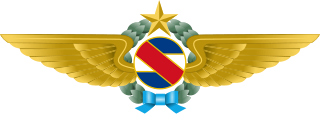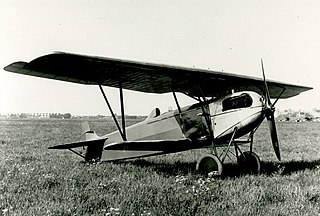Related Research Articles

The Focke-Wulf Fw 44 Stieglitz (Goldfinch) is a 1930s German two-seat biplane. Designed by Kurt Tank in 1931, it was the Focke-Wulf company's first major international success. Produced as a pilot training and sports flying aircraft. It was also built under license in several other countries.
Transportes Aéreos del Continente Americano, S.A., known and formerly branded as TACA International Airlines), and operating as Avianca El Salvador, is an airline owned by Kingsland Holdings and based in San Salvador, El Salvador. It is one of the seven national branded airlines in the Avianca Group of Latin American airlines, and it serves as the flag carrier of El Salvador.

The Cessna A-37 Dragonfly, or Super Tweet, is a light attack aircraft designed and produced by the American aircraft manufacturer Cessna.

The Cessna T-41 Mescalero is a military version of the popular Cessna 172, operated by the United States Air Force and Army, as well as the armed forces of various other countries as a pilot-training aircraft.

The Cessna 182 Skylane is an American four-seat, single-engined light airplane built by Cessna of Wichita, Kansas. It has the option of adding two child seats in the baggage area.

The Aermacchi AL-60 is a light civil utility aircraft of the late 1950s and early 1960s, originally designed by Al Mooney of Lockheed in the United States. After the company decided not to build the aircraft in the US, it was manufactured in small quantities in Mexico, and a few were assembled in Argentina by Aviones Lockheed-Kaiser Argentina. It was also built in quantity under licence by Aermacchi in Italy and Atlas Aircraft Corporation in South Africa.

The Uruguayan Air Force is the air service branch of the Armed Forces of Uruguay. Originally created as part of the National Army of Uruguay, the Air Force was established as a separate branch on December 4, 1953. It is the youngest and also the smallest branch of the Armed Forces of Uruguay. In 1977 it was determined that the mission of the Air Force is to conduct strategic and tactical aerospace operations on behalf of the national defense, exercising the sovereignty of the Uruguayan airspace and defending the independence, integrity, constitution and laws of the country. The Air Force must also conduct search and rescue missions and plan, propose, execute and supervise the necessary measures for the development of the aerospace potential, while providing any necessary and possible logistical support during the natural disasters that the country may suffer. Since 1985 this has been always carried out under the command of the President of Uruguay, and according to the Minister of National Defense.
The Aero Boero 260AG is an Argentine agricultural aircraft that first flew in 1973. Despite the similarity in designation, it is completely different from and unrelated to the Aero Boero AB-260.

The Cessna 188 is a family of light agricultural aircraft produced between 1966 and 1983 by the Cessna Aircraft Company.

The Cessna 185 Skywagon is a six-seat, single-engined, general aviation light aircraft manufactured by Cessna. It first flew as a prototype in July 1960, with the first production model completed in March 1961. The Cessna 185 is a high-winged aircraft with non-retractable conventional landing gear and a tailwheel.

The Cessna Model 404 Titan is an American twin-engined, light aircraft built by Cessna Aircraft. It was the company's largest twin piston-engined aircraft at the time of its development in the 1970s. Its US military designation is C-28, and Swedish Air Force designation Tp 87.

The Lockheed Martin A-4AR Fightinghawk is a major upgrade of the McDonnell Douglas A-4M Skyhawk attack aircraft developed for the Argentine Air Force which entered service in 1998. The program was named Fightinghawk in recognition of the F-16 Fighting Falcon, which was the source of its new avionics.

The I.Ae. 22 DL was an Argentine advanced training aircraft designed by the Instituto Aerotecnico in 1943, with a wooden structure, which resembled the North American NA-16.

The Gavilán 358 is a Colombian light utility transport aircraft of the 1990s. A high-winged monoplane powered by a piston engine, small numbers of Gaviláns were produced in the late 1990s/early 2000s, some serving with the Colombian Air Force.

The Fokker D.XI was a 1920s Dutch single-seat fighter designed and built by Fokker

The Macchi M.17 was an Italian racing flying boat built by Macchi for the 1922 Schneider Trophy race.

Industrias Aeronáuticas y Mecánicas del Estado was a state-owned entity and autarchic conglomerate of factories of Argentina created in 1951 to promote the manufacture of aircraft and automobiles during the Juan Perón administration.
The Moragon Stela is a Spanish two-seat fixed-wing microlight aircraft designed and built Aeromoragan based at Casarrubios del Monte, Spain. The aircraft was supplied as complete or as a kit for amateur construction.

The Colonel Jaime Meregalli Aeronautical Museum in an aviation museum located in Ciudad de la Costa, Canelones.
References
Footnotes
- ↑ Descriptions of the degree of similarity between the two types range from there being only small differences ("El Pijao, armado por Aviones de Colombia, era idéntico al Cessna Ag-Truck, con ligeras modificaciones..." [2] — "The Pijao, assembled by Aviones de Colombia, was identical to the Cessna Ag-Truck, with slight modifications") to describing the Pijao as an "all new" design. [4]
- ↑ see: 1998–2002 Argentine great depression